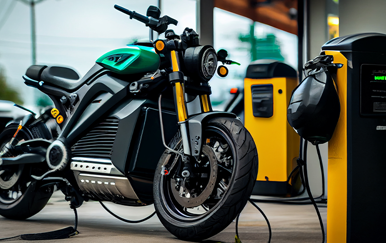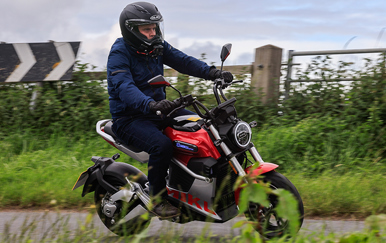Part of choosing an electric motorcycle, scooter, or moped is choosing how you’re going to charge it. It is important to find out if you need a charging point at home and how to get it installed.
Whether you’ve finally decided to upgrade to an electric motorcycle or you’re just doing some research, it’s important to think about how you’re going to charge it. Most electric vehicle (EV) owners choose to install a charger at home so they can charge their bikes at their leisure. But what is an EV charging point, do you need one at home, and how do you install and maintain them?
What is an electric vehicle (EV) charging point?
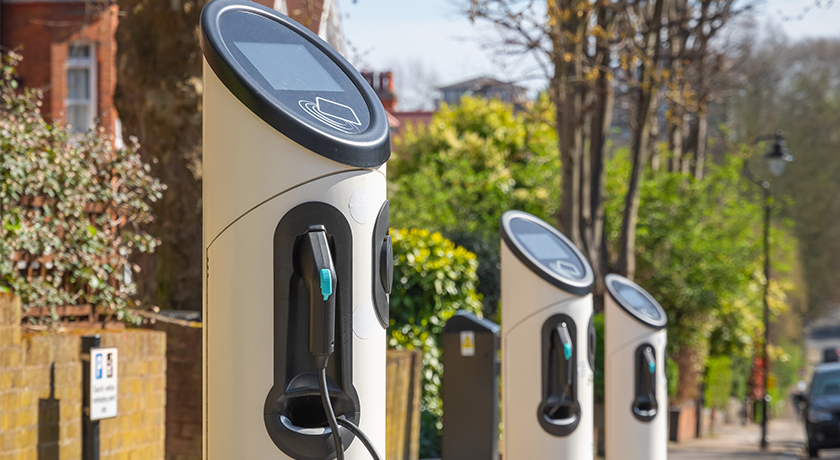
An EV charging point is a weather-proof installation that can recharge your electric vehicle. It will typically be mounted on an internal or external wall, depending on where you store your vehicle, and connects to your vehicle via a dedicated power cable.
Quick guide to electric vehicle (EV) charging levels
There are three types of EV charging points, and which one you’ll need depends on the type of vehicle you buy.
Level 1: 2.3kW 3-pin, 3.6kW 16A (slow - better suited for overnight charging)
Level one charging refers to plugging the cable (that came with your electric motorbike) into a standard household outlet - making the level 1 charger most suitable for overnight charging.
Unfortunately, charging your bike or moped this way happens to be the slowest out of the levels as they can only deliver 2.3 kW power at a time, equating to 4.5 hours of charging time to get a Zero SR/F to 95%, and 11 hours to charge a Harley-Davidson Livewire One to 100%.
Level 2: 7.4kW single-phase, 11kW 3-phase, 22kW commercial (fast)
Level two chargers come in models ranging from 7kW to 22kW, and are found everywhere - they are slow enough to be installed at homes and businesses, but fast enough for public stations.
The more common level two charger is typically the 7kW version, which is perfect for overnight charging. However there are a very small number of 22kW chargers out there, usually reserved for larger businesses and their employees.
Charging your bike with a level 2 charger can reduce charging times to 2 hours for a Zero SR/F.
Level 3: Ranges from 50kW (rapid) to 350kW (ultra-rapid)
Level three is where you will find the high-speed 50kW to 100kW plus chargers.
Typically, you will only find rapid and ultra-rapid chargers in public places, where you'll find they cost a lot more than you pay for domestic electricity.
A level 3 charger can fully charge your bike within just 1 hour, making it ideal for anyone who needs to “fill up the tank” in a short space of time. The only downside of these types of chargers is their price.
Level 4: 1 MegaWatt+ (also known as mega chargers, for lorries and larger commercial vehicles)
The last level of charger is level four, suitable for lorries and larger commercial vehicles.
Level four chargers are the fastest and latest chargers on the market right now, delivering over one megawatt of power and taking no more than 20 minutes to fully charge an electric vehicle.
Typically chargers such as these will be found where EVs with huge batteries, such as trucks and lorries, are used.
What level electric chargers are used for two wheelers?
Typically, level one and two chargers tend to be the most common for two wheelers. Level one chargers tend to cover smaller capacity electric mopeds and scooters whereas level two chargers tend to be the standard for larger capacity motorcycles.
Questions to ask before installing a charge point
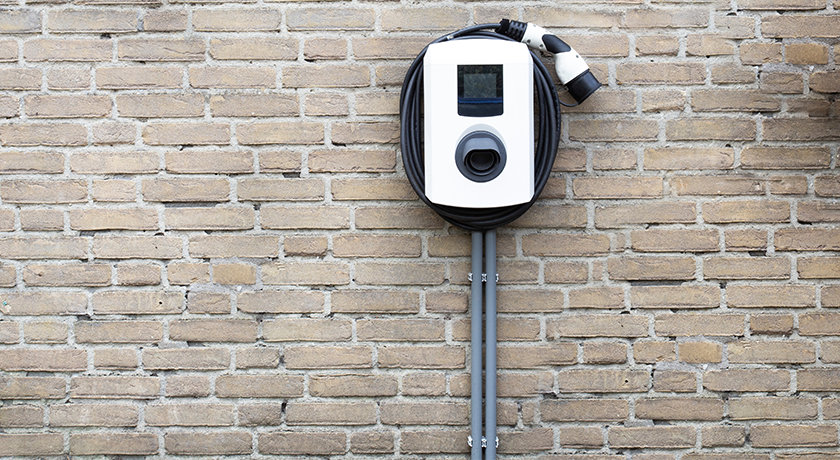
Installing an EV charging point at your house, even with the grant can be quite expensive to install and also to maintain.
That is why is it so important to think about certain things such as:
Is it worth installing a charger?
If you own a motorcycle that requires a charger, then naturally it is extremely advisable to get a charger installed at your property, it will be default option to get one installed at home for the majority of people.
A benefit of owning an at-home charger also means that you can save yourself a fair bit of cash in comparison to using public chargers!
Does your scooter or bike have a removable battery?
If your scooter or motorbike has a removable battery, this may mean that you will not require an EV charging point. Removable batteries can be taken inside and charged up via a normal 3-pin plug, which can ultimately help you save a few pennies when not having to install a charger.
How will you use your electric scooter or motorbike?
Naturally, the use and regular location of your vehicle will affect what option you go for.
If you are blessed with something like a communal car park that has charging ports ready to go or a nearby public charging point your prayers are answered without an additional outlay.
However, if this is not the case, then the investment to get an at-home charging point is basically a necessity. Plus it has the bonus of being cheaper than road side services.
How much do charging points cost?
Depending on the type of charger you opt for, you could be looking at spending anywhere between £200 and £1600. However, there is help available to offset the cost.
The Office for Low Emission Vehicles (OLEV) offers a grant for the installation of charging points, offering up to 75% towards the cost of installing electric vehicle charge points up to a maximum of £350 (including VAT). To be eligible for the grant, you must:
- Own an OLEV-approved vehicle.
- be using an authorised installer
- be installing a charge point for a vehicle that is also eligible for the Plug-in Motorcycle Grant
- have private off-street parking (if you don’t have off-street parking, some Local Authorities are offering their own schemes).
You can claim the grant for a second charging point if you have a second electric vehicle, as well as potentially having the ability to claim the grant if you are installing a charge point for a company vehicle or a leased vehicle.
Some manufacturers also run offers and deals that will help you to cover the costs of your charging point.
How to install a home EV charge point for your motorcycle:

If you’re looking to install an EV charging point yourself, the answer is you can’t.
Unless you’re an electrician with experience in fitting EV chargers, it is not even worth attempting this yourself. There are reasons why you should leave it to the professionals such as:
- Using an experienced and certified installer is safer and will ensure your charger is properly and safely installed.
- Your charger will not comply with the regulations.
- You may risk losing your warranty for not having an EV charge point installed by a certified electrician.
How to find an authorised charging point installer
If you want to claim the OLEV grant for your charging point installation, you will be required to use an authorised installer.
If you aren’t eligible for the grant, or you aren’t claiming the grant, it’s still important to choose a certified installer. They’ll make sure that the installation meets the necessary safety standards. Not all electricians will be aware of these.
Thankfully, there are tools out there that can help you find an installer such as the GOV.UK website and Zap-Map - all you need to do is put in your postcode!
Maintaining your electric motorcycle charging station at home
Once you have installed your charging station, it is important to maintain it, especially for the health and safety of yourself and others.
How often do EV charge points need maintenance?
We would recommend you service your EV charging point every twelve months.
Servicing your charging point is an essential part of EV maintenance, and there will be specialists on hand from the supplier able to check that your charging point is working both efficiently and safely.
How to clean an EV charge station
Cleaning your EV charging point should be a fairly simple task to carry out.
It is recommended that you use a damp cloth when cleaning the body of the charger, and a dry cloth when cleaning the connector. This is because while the unit itself is waterproof, the connector is not and needs protecting - we would also recommend you power down your charging point for attempting to clean it, taking extra precautions to keep you safe.
When it comes to the port of your charger, cleaning this part can be a little trickier. If you notice that your electric motorbike or scooter isn’t charging as efficiently, you may need to clean the port that attaches your vehicle to the unit. You can do this by gently using a q-tip to remove any debris.
However, it is worth noting that it is vitally important to follow manufacturer guidance and precautions at all times, and follow official instructions on the device and vehicle you have. Only tackle maintenance tasks you are competent enough to do so.
How to protect your EV charging cable from theft
Charging your electric motorbike and scooter at home is one of the best ways to minimise the theft of EV cables.
Installing your EV charger either in a garage or keeping it out of view from the street will help it keep out of sight from potential thieves' eyes.
Whilst some EVs come equipped with locking mechanisms, unfortunately, this measure is not always foolproof. Thieves using brute force can be just enough to unlock mechanisms.
There are a few ways in which you can keep your charging point and vehicle safe such as:
- Installing CCTV/security cameras
- Putting your EV equipment in a secure garage
- Consider investing in a wall box charger that comes with a tethered cable.
- If possible, try to avoid installing the EV charger on the driveway
Check your warranty and get insured
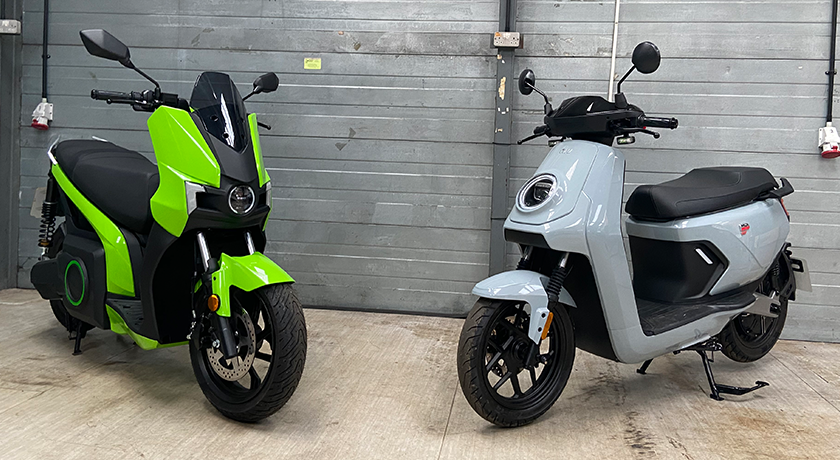
The electric motorcycle market is still in its infancy (and if you have any more questions you can check out our electric scooter and motorcycle FAQs), so we’re always interested to hear what our readers think…
If you’ve already got an electric bike, which charger did you choose and why? Or, if you’re thinking about upgrading to electric, which charger would you go for? Let us know in the comments; we want to hear from you!
Last but not least, if you have your very own electric motorcycle you need to insure - make sure to get a electric motorcycle and moped quote direct with Lexham!



